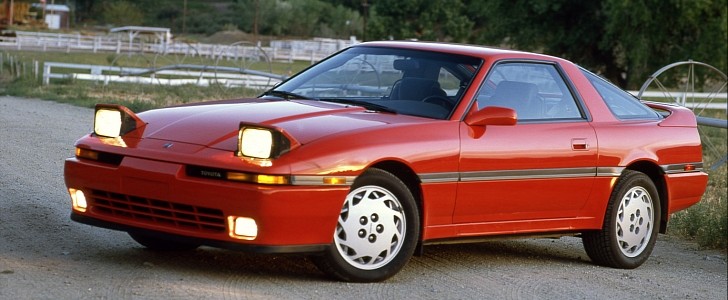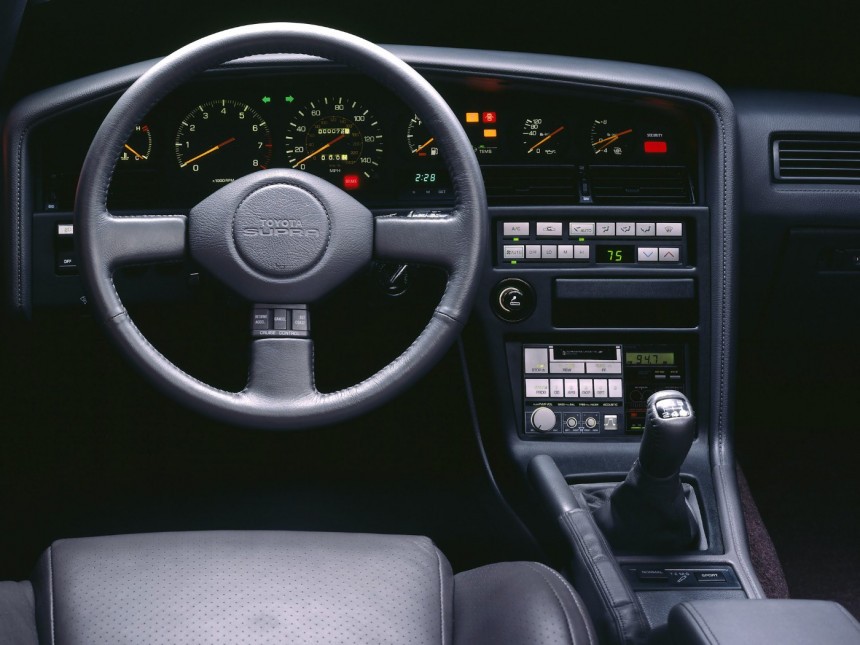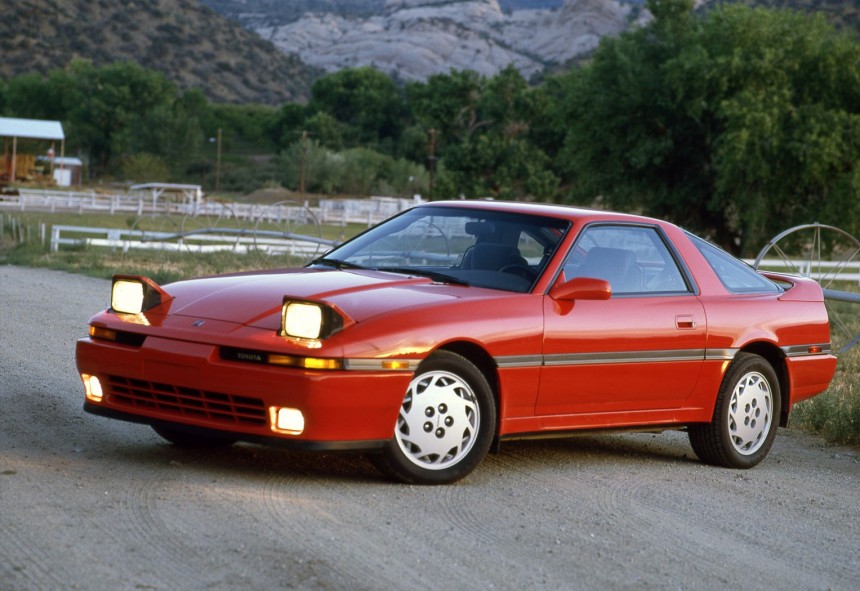While the Celica started to be more successful in the rally world, customers asked for more street performance, which couldn't be provided with four-banger engines. So the automaker decided to split the Celica from the Supra.
The third generation of the Supra was the first as a stand-alone model. Unlike its former companion nameplate, Celica, it was built as a sports car that kept its rear-wheel drive platform, albeit improved over its predecessor model. The divorce between these two nameplates ran smoothly. Somehow similar to the one between the Bel Air and the Impala, albeit two decades later (give or take a couple of years). Nevertheless, the new model aimed at European sportscars, such as the Porsche 944 and the American sports and pony cars.
The Supra came with its naturally-aspirated three-liter inline-six to compete against the Mustang SVO, which sported a 2.3-liter turbocharged powerplant. And, despite being a heavy car, the Supra came on top over the American pony car on a quarter-mile run. Most importantly, it was better on the brakes. So, was the divorce from the Celica worth it? I guess so.
For starters, the car was quite heavy for its class, with its curb weight of over 3,500 lb (1,611 kg) due to the added luxury amenities fitted in the vehicle. Not even the available TEMS (electronically adjustable dampers) could shave those pounds while cornering. In addition, the automaker also offered the Supra with a single-piece removable top that made the car flexing on the bends. Over time, that nice-looking feature became a nightmare during rainy days.
Moving on to the interior, we noticed the very well-organized instrument cluster that featured most dials needed for a sports car, apart from an oil-pressure gauge. But the high-bolstered seats and the flat-folding rear bench from this 2+2 Supra were highly appreciated by its customers. In addition, it featured automatic climate control and a stereo-cassette player with an equalizer. Last but not least, the Supra featured not one, but two antennas! A powered one in the right-rear quarter panel and a second one integrated into the large rear windscreen.
With its sporty styling, even if it was longer than the Mustang and the Corvette C4, but shorter than the Camaro, the Supra was up for a promising start. Still, those 200 ponies under the hood were not exactly what customers wanted. So, in 1987, Toyota introduced a turbocharged version that increased the power to 231 hp (236 PS), but most importantly, it raised the torque to 240 lb-ft (340 Nm). In addition, it came with a limited-slip differential that greatly impacted the car's behavior.
The Supra was safe on winding roads thanks to its double-wishbone suspension in all corners. Another plus point for it was related to the brakes. The ABS was available as an option for the entire range. But even without it, it could beat a Fox body Mustang SVO by a car length in the stopping distance from 55 mph (88 kph) to zero.
Unfortunately, only the Japanese customers were able to get the twin-turbocharged 1JZ-GTE engine that produced 280 PS (276 hp). The rest of the world had to find other ways to increase the power with some help from the tuning industry.
But the big question is: is it worth reconsidering it? Sure, it's not as expensive as a fourth-generation Supra, and it doesn't have that mighty 2JZ engine under the hood. But still, for a classic sports car, it can be satisfying. It can carry two people over long distances, it's quite good at high-speed cornering, and its pop-up headlights are still loved by many. Unfortunately, the car came fitted with 16" alloys from the factory. There were some aftermarket options for 17" wheels, so you don't have too many choices there.
In 2022, several turbocharged 1990 Supras were sold for less than 20k, so you might still get one for less than the money you'd spend on a brand-new econobox. Moreover, even in its stock form, it could do the naught to sixty (0-97 kph) run in about six seconds, which is no slouch. Sure, if you compare it to many electric cars or modern sports cars, it's not that good. But on the streets, you know that this is more than enough.
So, in terms of bang for your buck, the Supra III might be just enough to satisfy your sporty driving style. Heck! You may even take it to a track and still have some fun tossing around the corners. Because this is what's good with these old dogs: having fun without breaking the bank. And that's not something you can say about the Supra IV. I know, it's everybody's darling. But you'll hardly find a good example for less than 40k. That's twice as much as a Supra III, and you might not get double the fun with it.
So yeah, if you know how to drive, you don't want to get in trouble with the boys in blue, but still want to show up in a stylish, classic Japanese car, the third-generation Supra surely fits the bill. And it's a Toyota, so if you can find a well-maintained example, you'll enjoy it on the streets more than you'll see it in your garage.
The Supra came with its naturally-aspirated three-liter inline-six to compete against the Mustang SVO, which sported a 2.3-liter turbocharged powerplant. And, despite being a heavy car, the Supra came on top over the American pony car on a quarter-mile run. Most importantly, it was better on the brakes. So, was the divorce from the Celica worth it? I guess so.
For starters, the car was quite heavy for its class, with its curb weight of over 3,500 lb (1,611 kg) due to the added luxury amenities fitted in the vehicle. Not even the available TEMS (electronically adjustable dampers) could shave those pounds while cornering. In addition, the automaker also offered the Supra with a single-piece removable top that made the car flexing on the bends. Over time, that nice-looking feature became a nightmare during rainy days.
Moving on to the interior, we noticed the very well-organized instrument cluster that featured most dials needed for a sports car, apart from an oil-pressure gauge. But the high-bolstered seats and the flat-folding rear bench from this 2+2 Supra were highly appreciated by its customers. In addition, it featured automatic climate control and a stereo-cassette player with an equalizer. Last but not least, the Supra featured not one, but two antennas! A powered one in the right-rear quarter panel and a second one integrated into the large rear windscreen.
The Supra was safe on winding roads thanks to its double-wishbone suspension in all corners. Another plus point for it was related to the brakes. The ABS was available as an option for the entire range. But even without it, it could beat a Fox body Mustang SVO by a car length in the stopping distance from 55 mph (88 kph) to zero.
Unfortunately, only the Japanese customers were able to get the twin-turbocharged 1JZ-GTE engine that produced 280 PS (276 hp). The rest of the world had to find other ways to increase the power with some help from the tuning industry.
But the big question is: is it worth reconsidering it? Sure, it's not as expensive as a fourth-generation Supra, and it doesn't have that mighty 2JZ engine under the hood. But still, for a classic sports car, it can be satisfying. It can carry two people over long distances, it's quite good at high-speed cornering, and its pop-up headlights are still loved by many. Unfortunately, the car came fitted with 16" alloys from the factory. There were some aftermarket options for 17" wheels, so you don't have too many choices there.
So, in terms of bang for your buck, the Supra III might be just enough to satisfy your sporty driving style. Heck! You may even take it to a track and still have some fun tossing around the corners. Because this is what's good with these old dogs: having fun without breaking the bank. And that's not something you can say about the Supra IV. I know, it's everybody's darling. But you'll hardly find a good example for less than 40k. That's twice as much as a Supra III, and you might not get double the fun with it.
So yeah, if you know how to drive, you don't want to get in trouble with the boys in blue, but still want to show up in a stylish, classic Japanese car, the third-generation Supra surely fits the bill. And it's a Toyota, so if you can find a well-maintained example, you'll enjoy it on the streets more than you'll see it in your garage.









